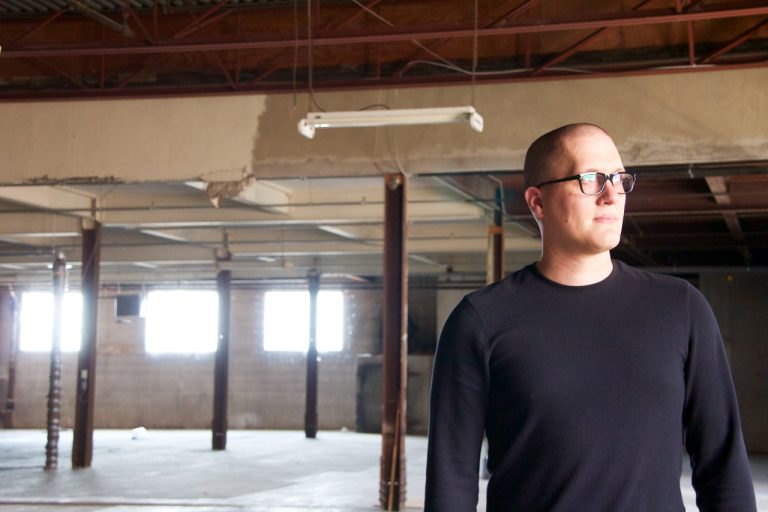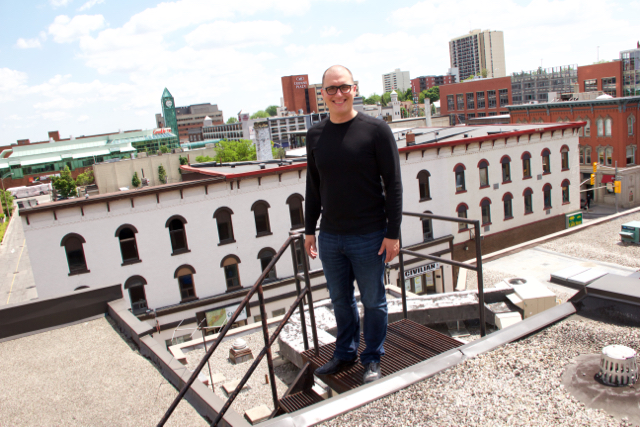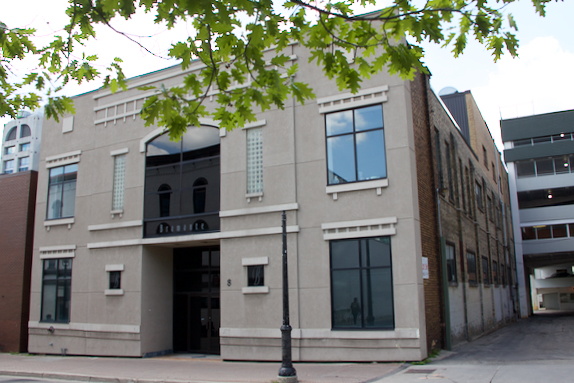When a young man named Frank Voisin set out to start a family in the early 1940s, he faced a dilemma: Try and buy a house for $7,000, which he couldn’t afford, or attempt to build his own for $3,000, a cheaper but more challenging proposition.
Voisin decided to build, and once he started, he couldn’t stop. Before long, he was the biggest residential developer in Kitchener-Waterloo, and by 1970, he’d built more than 1,000 homes in rapidly growing subdivisions like Forest Hill, Stanley Park and Forest Heights.
His entrepreneurial descendants have been similarly successful – son Mac Voisin co-founded M&M Meat Shops, a coast-to-coast retail boxed-food chain that boasted 456 outlets at its peak; and Greg Voisin is a partner in The Boardwalk, a vast retail development along Ira Needles Boulevard in Kitchener and Waterloo.

Looking to the future: Frank Voisin on the top floor of 8 Queen.
(Communitech photo: Anthony Reinhart)
This week, another young man named Frank Voisin – son of Greg and grandson to the original Frank – took on an ambitious project of his own, along with brother Steve, in another fast-growing development segment.
The brothers unveiled plans for 8 Queen St. N. in Kitchener, a rare and spacious brick-and-beam building they recently bought, smack in the centre of a downtown teeming with high-potential tech companies that covet just that kind of space.
While the Voisin name has been synonymous with suburban development in Waterloo Region for decades, 8 Queen is the first family foray into the downtown core (though, as Frank and Steve pointed out, they’re pursuing the project on their own, without family backing).
The 8 Queen project – and the Voisins’ commitment to it – is symbolic of a larger trend that has seen tech companies and young employees flocking to urban cores, where historic buildings, restaurants, events and street life offer a vibrant alternative to suburban working life.
In this particular case, it means 33,000 square feet of Class A office space spread over three storeys in what started as the Goudies department store in 1925. The store eventually expanded around the corner onto King Street, into what is now THEMUSEUM.
While the Voisin property is a separate entity, it remains attached to THEMUSEUM, and boasts a long list of enviable attributes: Sprawling, open-concept floor plates, polished hardwood floors, high ceilings, a connected city parking garage, proximity to restaurants and the future light rail transit line, 2,500 square feet of rooftop with great patio potential, high visibility to the busy intersection of King and Queen streets, and room to grow vertically if future demand warrants it.
I dropped by 8 Queen this week for a tour, made all the more visually interesting by the fact that the previous owner, a maker of liturgical robes and artwork for churches worldwide, is still in the process of moving out.
Then I sat down with Frank and Steve Voisin to chat about their vision for the building.
Q – When did you become aware of this property as something you might want to get involved in?
Frank – Like most people in the region, neither Steve nor I had ever been inside this building.
They had listed it for weeks, and based on the interior photos, it was enough for me to call Steve and say, ‘Let’s get into this building.’ When we came through, I think we both were extremely impressed with what we saw.
There was a period of time where we had to win Abe (previous owner Abraham Mathew) over on the idea of selling rather than leasing, because he had had a couple of bad experiences trying to sell in the past. So, it all worked out.
This was late October of last year. We had the deal done Dec. 1.
Q – Ideally, how many floors will you be adding, and what will this building become?
Steve – I think Phase 1 is to do the third-floor expansion at the front and a new façade and fill up the building. Before we do an expansion vertically, we’d have to figure out this block.
Frank – I wouldn’t say we have a quota in mind. The goal is to come up with the best possible product at this corner. Whether or not that ultimately looks like a five-storey or a 25-storey building really depends on the market.
A lot is going to change with the LRT, and a lot is changing now with Google coming in, with (condos such as) One Victoria, 100 Victoria, City Centre, and the Arrow Lofts second phase. So, it’s really hard to predict what’s going to happen in five years.
Steve – Our goal is to finish this one off very well, fill it up with tenants who are very happy, and then figure out the next game plan.
Q – How much space is available in this building?
Frank – The building is 40,000 square feet, and we’ll be making available approximately 33,000. The other 7,000 is basement right now; it would be a great server room.

Frank Voisin on the roof of 8 Queen. The building is highly visible from the busy downtown
intersection of King and Queen streets. (Communitech photo: Anthony Reinhart)
Q – Is this building more ideally suited to one large tenant than several smaller ones?
Frank – It’s not that it’s more ideal for us; I think it’s a symbiotic thing.
For large tenants, there are a number of tenants, particularly on the tech side, that are growing rapidly. When they look out 18 months and realize that they’re fast outgrowing the space they’re in, they say, ‘What are we going to do? Are we going to split (operations) between buildings? Are we going to have to go into traditional office space? Are we going to have to go out to the suburbs?’, which, for many of them, is anathema to their culture.
If we chop this up into 2,000-square-foot-units, we’re competing with 10 other buildings which are doing an adequate job of servicing those companies now, and there’s going to be no one to service these very large companies.
That’s why we’re focusing on the larger users.
And also, the ability to brand – the whole building could be known as the XYZ Tech Company Building, with prominent signage on the front and on the side. And we’ve got a fairly large rear wall facing Ontario Street that City Centre (condos) will be looking right out on.
It would be a great blank slate for them to add a cool mural based on their company, similar to what you see at Vidyard on their walls. Imagine the whole back wall being done up for one of these companies.
Having said that, we’re not hell-bent on this being purely a tech space. We’re finding that more and more traditional companies – finance, consulting, law, insurance – are looking for this kind of stuff. It’s a differentiating factor.
Think about it as a customer – do you want to go to the bland space with poor parking, no amenities, maybe out in the suburbs or maybe not, but just traditional? If you walked into this and your lawyer was here, with high ceilings and a gorgeous office, it would be different, particularly for those traditional companies that are trying to appeal to the startups, the tech companies.
Steve – I think the other opportunity for a large tenant is that, if there were a large user that’s not represented in the K-W market, this would be a great building for them to come into.
There have been discussions with cellphone companies about coming here; if they’re going to make the move, they’re not making the move into 2,000 square feet. They’re going to make a big move, like Google did.
Q – What about price? The downtown has clearly become more popular, and yet, we’ve seen quite a few businesses in the core close down recently.
Steve – I think it’s more operator based. If you have a good operator, you end up staying in business, and if you have a bad operator, you end up going under.
That applies to retail or restaurants or anything. If you’re a good operator and you attract customers, you’re going to stay open.
Frank – But that’s particularly true for those who are adaptable.
If you’ve been here for the last 15 years, you may have been enjoying extremely low rents. We’ve also had very little demand, because the core has not been what it’s now becoming.
Now, we’re in a position where suddenly everybody wants to be here, and rents are going up. Can those people who’ve been operating here adapt to higher rents and still remain competitive?
It’s a sea change. We’re witnessing, on a daily basis, gentrification.
Some people might want to bemoan the mom-and-pops that are closing up, but we’re seeing a lot of mom-and-pops opening as well. Gilt is not a big corporate-backed company; they have one other restaurant. In the Duke Food Block, a lot of those (restaurants) are independents.
We’re seeing more and more independents opening, as well as a bunch closing, which I think is exactly what Steve’s saying – who’s adaptable and who’s not? Who can appeal to the changing demographics of the core?
What we do know is that there are going to be a lot more people living and working here in the years to come.
Steve – This is Class A office space, so you pay for what you get.
It’s not really geared towards startups.
Frank – Not the earliest-stage startups, anyway.
Steve – If you’re in a rapid growth stage, you start to look at these kinds of spaces to keep your employees happy.
Frank – But as you’ll see in the marketing package on the website, we’re asking $20 net and our TMI (taxes, maintenance and insurance) is about $6, so all in, $26 a square foot is not too different from what you’d see at a lot of the buildings in the core.
We’re targeting that gross mid-$20s range that is not out of line with the rents we’re seeing that companies as small as 10 people in the Tannery all the way up to 200 people in their own building are paying.
There is an argument to be made that if you’re coming into a market with a premium product, you charge a premium price, but if you look at everything that’s available today, and comparable properties over the last three years, which we’ve done, we are absolutely in the middle of that.
We are providing a premium product, but we’re not charging that premium price for it.
Steve – We’ve sized the elevator and washrooms so that we can have 100 employees per floor. So, when you talk about cost per square foot, you can have a higher density in this building than you might on another building.
So, we could have upwards of 300 people working in this building.
Q – Do you have any other properties in the core, or is this your first foray?
Frank – This is our first foray into the core.
Steve and I are huge believers in what’s happening in the core. It’s plainly obvious to anyone looking around at the stuff happening here – TWH Social, Gilt, great condos, all the tech companies, LRT coming in – it’s hard to look around and not want to be part of the rejuvenation of the core.
Q – The history of the development business in your family has largely been a suburban one. Tell me about this new direction.
Frank – We’ve seen decades of growth in the suburbs, and – not that the suburbs aren’t growing – but we’re now seeing a little bit of a pendulum swing back to massive growth in the core, or at least relatively more rapid growth in the core over the next 10 years than in the suburbs.
Steve – Which is indicative of every other city in southern Ontario. What happened to Kitchener is the same as what’s happened elsewhere, and as people appreciate the historic value of these buildings – the high ceilings, the wood floors – it’s a great opportunity to collaborate in an open space, and this is a great building to do it.
Q – Frank, you also live in the core, in Waterloo. In fact, we’re neighbours. Why do you want to be downtown, personally and professionally?
Frank – We’re making the business decision to invest in the core, obviously for financial reasons, for business reasons.
Personally, my partner and I live in the core, and we’re not buying the house because we think it’s going to go up in value more than in the suburbs; we’re there because of the lifestyle, the ability to walk.
I lived abroad for a number of years, in places that were highly transit-friendly. You didn’t have to own a car; everything was happening in the core; we lived in the core. The opportunity to walk uptown, to walk downtown, to not have to take your car out every single day, was extremely appealing.

8 Queen as it looks today. Frank and Steve Voisin plan to remove the stucco and
restore the original brick facade. (Communitech photo: Anthony Reinhart)
Q – So you’re living the same lifestyle as many of the people who are flocking down here to work and run businesses.
Frank – Absolutely.
The houses are smaller and they’re older, so it’s a tradeoff for sure, but for us, it doesn’t feel like much of one. We can just walk uptown and everything’s at our doorstep. Plus, we like old houses.
Q – Did your grandfather, Frank Voisin, come from a construction background in his family?
Steve – No. Our grandfather started building because he couldn’t afford his first house, so he had to build it.
Frank – The story was along the lines of, ‘If you buy a house, it’s $7,000, but if you build it, it’s $3,000.’ So, they built the first one, sold it and used the profits to build the second.
Steve – The first one was not far from where you live (in the Waterloo core).
It was in that area and he just kept on going. And, in the end, he built upwards of 1,000 homes in subdivision after subdivision – Stanley Park, Forest Hill, Forest Heights.
He was building homes between 1945 and 1970.
Frank – Back then, it was a very different game compared to today. He was larger than the next three or four guys combined, but to do 1,000 was a huge amount back in those days.
Q – Does that local family legacy weigh on you, or is this just what you do?
Steve – I think it’s just what you do. We’re both good at real estate, so it’s not like we need to lean on anyone else.
Frank – Our family’s not involved at all; this is purely Steve and I. We found outside financing, everything.
Steve – We have the expertise to develop this. I don’t think there’s a legacy sitting behind us; this is just another project. This is what we love to do, and we’re good at it and look forward to it every day.
We continue to move things forward, and in the end, there’s a grand opening and a celebration and you go on to the next one.
Frank – We were exposed to real estate. If our family had been butchers, we would have been exposed to that.
The only legacy thing I would think about is the idea that reputation matters. We wouldn’t be doing deals that we didn’t fully believe that we had the ability to execute on, not just for our own satisfaction, but also, we don’t want to tarnish our name.
We’re excited to bring our family name to the core, because we’ve traditionally not been involved in the core, but we’ve been big developers out in the suburbs.
Steve – You’re dealing with someone who can execute on the deal. You’re not dealing with some fly-by-night landlord; if you’ve got a problem, we’re here right away. And when we build things, we do it right. We don’t cut corners or cheap out.
We’re investing in our own community, and I think that’s important. We’re choosing to invest in Kitchener.
View from the ‘Loo looks at the issues, people and events that shape Waterloo Region’s technology sector.

